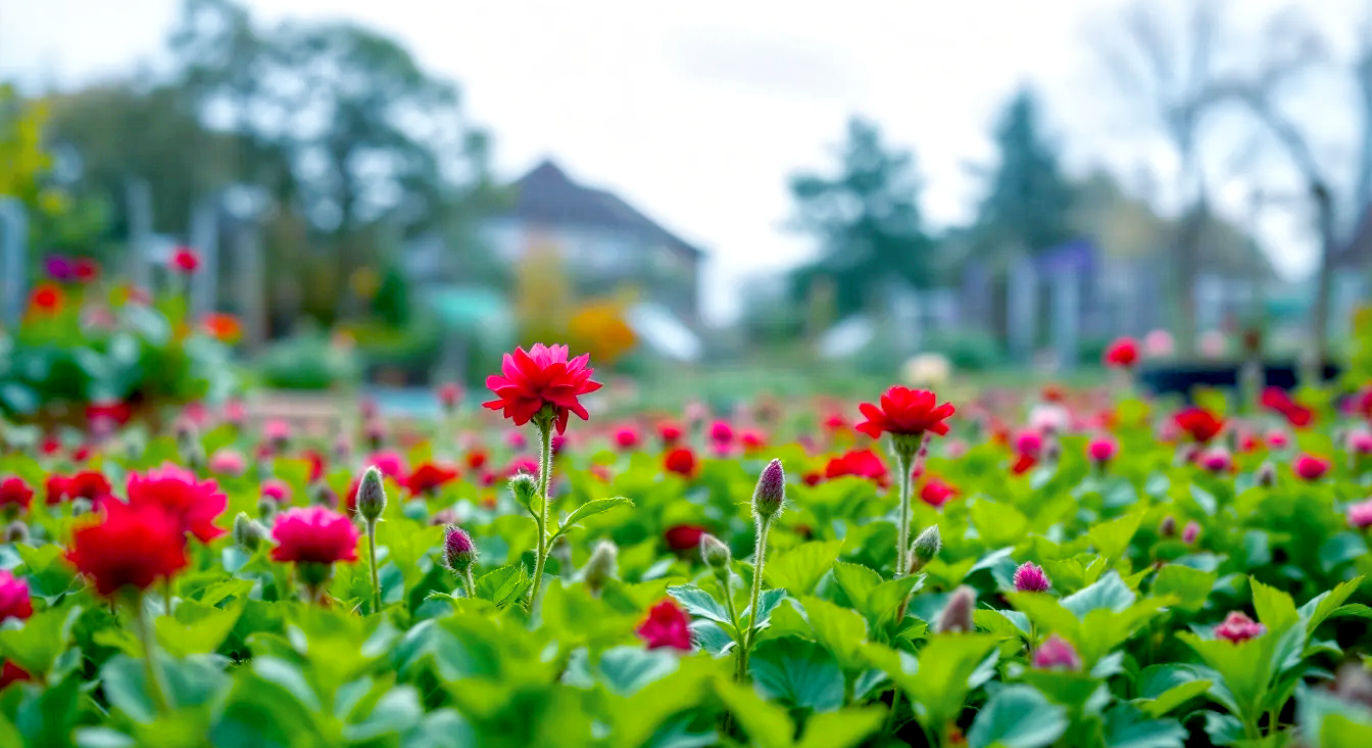The Guide to Green Manures: Britain’s Secret Weapon for a Thriving Garden
Unlock the secrets of healthy soil. Learn how to use green manures to enrich your British garden, suppress weeds, and grow healthier plants. Read on.

This post may contain affiliate links. If you make a purchase through these links, we may earn a commission at no additional cost to you.
Ever wondered how our grandparents managed to grow such prize-winning leeks and vibrant roses without a shed full of chemical fertilisers? They had a secret, an ancient trick that’s making a huge comeback in gardens and allotments across Britain. It’s called green manuring, and it’s one of the simplest, cheapest, and most effective ways to build incredible soil fertility.
Forget everything you think you know about feeding your plants. We’re not talking about mucking out stables or buying bags of pellets. We’re talking about growing plants specifically to feed the soil. It sounds a bit odd, doesn’t it? Like buying a doughnut just to look at it. But trust us, once you understand the magic happening beneath your feet, you’ll see that green manures are the unsung heroes of the garden.
From the rolling fields of the Cotswolds to the tight-knit allotments of inner-city London, gardeners are rediscovering this technique. It’s a way of working with nature, not against it, to create a garden that’s bursting with life. This isn’t just about growing bigger veg; it’s about creating a healthy, resilient ecosystem right in your own back garden. So, grab a cuppa, get comfortable, and let’s dig into the wonderful world of green manures.
What on Earth Are Green Manures?
Let’s get straight to it. Green manures are plants grown to improve the soil. That’s the long and short of it. Instead of growing them for their flowers, fruit, or veg, you grow them for a season and then dig them back into the ground before they set seed. Think of it as a home-grown, living fertiliser.
When these plants are dug in, they rot down and release a whole host of goodies that your soil—and the plants you actually want to eat—will absolutely love. They are often called ‘cover crops’ because they blanket the soil, protecting it from the elements, especially during our notoriously wet and windy British winters.
You wouldn’t leave your house without a roof, so why leave your precious soil bare? An empty bed is an invitation for two things: weeds to move in and for rain to wash away all the valuable nutrients. A green manure acts like a protective green duvet, keeping everything tucked in and safe until you’re ready to plant your main crops.
The Basic Idea: Grow, Chop, Dig
The process is brilliantly simple:
- Grow: You sow the green manure seeds on a patch of empty soil. This could be after you’ve harvested your potatoes in late summer or on a bed you’re leaving fallow for a season.
- Chop: Before the plants start to flower and produce seeds, you chop them down. You can use shears, a strimmer, or even a lawnmower on a high setting.
- Dig (or Don’t!): You then incorporate the chopped foliage into the top layer of the soil. Traditionally, this means digging it in. But for those of us following a ‘no-dig’ method, you can simply leave the chopped material on the surface as a mulch to rot down naturally.
That’s it. You’ve just given your soil a massive, nutritious meal that will set it up for a fantastic growing season.
A Potted History: Green Manuring in Britain
This isn’t some trendy new idea dreamed up by gardening influencers. The practice of using green manures is as old as farming itself. The Romans were big fans, with writers like Cato and Pliny the Elder talking about ploughing in beans and lupins to enrich their fields.
In Britain, the idea has waxed and waned. It was a cornerstone of medieval farming, part of a clever system of crop rotation that kept land productive for centuries. Farmers knew that planting clover or vetches in a field one year meant a better wheat harvest the next. They might not have known the exact science of nitrogen fixation, but they saw the results.
Then came the 20th century and the ‘Green Revolution’. With the invention of cheap, powerful chemical fertilisers after the Second World War, these old, slower methods fell out of favour. It seemed easier to just sprinkle on some chemicals from a bag. But this quick fix came at a cost. Over time, soils became depleted of organic matter, lifeless, and dependent on ever-increasing doses of artificial inputs.
Now, the pendulum is swinging back. With a growing understanding of soil health, sustainability, and the damage that chemical-heavy farming can do, green manures are being recognised once again for the incredible tool they are. From large-scale organic farms to the humble back garden, people are realising that feeding the soil is the first step to feeding ourselves.
The Science Bit: How Do Green Manures Actually Work?
So, what’s the magic happening underground? When you dig in a green manure, you’re kick-starting a whole chain of brilliant natural processes. It’s a bit like a complex recipe with several key ingredients.
1. They Add Organic Matter (The Soil’s Sponge)
This is perhaps the most important job of a green manure. Organic matter is the dark, crumbly, lovely-smelling stuff that makes soil healthy. It’s essentially decomposed plant and animal material. When you dig in your green manure, you’re adding a massive dose of fresh organic matter.
Why is this so good?
- Improves Soil Structure: Organic matter acts like a glue, binding tiny soil particles together into larger clumps called ‘aggregates’. This creates a wonderful, crumbly texture. For heavy clay soils, common in many parts of the UK, this is a game-changer. It opens up the soil, improving drainage and stopping it from turning into a sticky, waterlogged mess in winter. For sandy soils, it does the opposite but is just as brilliant. It helps the soil hold onto water and nutrients like a sponge, stopping them from washing away after a downpour.
- Feeds Soil Life: This organic matter is a feast for an entire army of invisible helpers living in your soil: bacteria, fungi, worms, and countless other microorganisms. These critters are the real engines of fertility. As they munch away, they release nutrients in a form that plants can easily absorb.
2. They Fix Nitrogen from the Air (Free Fertiliser!)
This is the cleverest trick of all, and it’s performed by a special group of green manures called legumes. This family includes plants like clovers, vetches (tares), field beans, and lucerne.
Our air is about 78% nitrogen, which is a vital nutrient for leafy green growth in plants. But plants can’t just breathe it in. They need it to be ‘fixed’ into a usable form in the soil. Legumes have a unique superpower: they form a partnership with special bacteria called Rhizobia. These bacteria live in little nodules on the plant’s roots and have the amazing ability to capture nitrogen from the air and convert it into plant-friendly nitrates in the soil.
When you grow a legume green manure, you’re essentially running a little fertiliser factory in your garden, for free! Digging in a crop of clover can add as much nitrogen to your soil as a generous dressing of traditional manure. It’s perfect for preparing a bed for heavy-feeding, leafy crops like cabbages, kale, and lettuces.
3. They Prevent Nutrient Leaching (Holding onto the Good Stuff)
Bare soil is leaky soil. When it rains heavily (and let’s be honest, that’s a regular feature of the British climate), water percolates down through the soil, washing valuable nutrients like nitrates and potassium away with it. This is called ‘leaching’.
A green manure crop acts like a safety net. Its roots grow deep into the soil and mop up these soluble nutrients, storing them in their leaves and stems. When you chop the plant down and incorporate it back into the soil, those nutrients are released right where your next crop can use them. It’s the ultimate recycling system. Some green manures, like grazing rye, have incredibly deep and extensive root systems, making them fantastic for this job over winter.
4. They Suppress Weeds (A Living Mulch)
Nature abhors a vacuum, and a patch of bare soil is a vacuum just waiting to be filled by opportunistic weeds. A fast-growing, dense green manure crop will quickly cover the ground, out-competing weed seedlings for light, water, and space.
This is a huge help in organic gardening, reducing the need for back-breaking weeding or the use of herbicides. Plants like phacelia, buckwheat, and mustard are particularly good at smothering weeds.
Choosing Your Green Manure: The Right Plant for the Right Job
Not all green manures are created equal. Just like you’d choose different veg for different seasons, you need to pick the right green manure for your specific needs, your soil type, and the time of year. Here’s a rundown of some of the most popular and effective choices for British gardens.
The Legumes: Nitrogen Fixers
These are your go-to for boosting fertility, especially before planting nitrogen-hungry brassicas or leafy greens.
Winter Tares (or Vetches)
- Best for: Sowing in late summer or autumn to cover soil over winter. They are very hardy and will grow even in cool weather.
- Why we love them: Excellent nitrogen fixer. Their sprawling growth smothers weeds effectively. They are a classic choice for overwintering on a British allotment.
- Top Tip: They can be a bit floppy, so they are often sown with a companion like grazing rye, which acts as a living scaffold for them to climb up.
Field Beans
- Best for: Overwintering on heavy clay soil. Their strong, deep roots are brilliant at breaking up compacted ground.
- Why we love them: Very tough and reliable. They can be sown as late as October.
- Top Tip: Chop them down before they get too woody, as the thick stems can be slow to break down.
Crimson Clover
- Best for: Sowing in spring or summer for a quick fertility boost.
- Why we love them: As well as being a great nitrogen fixer, it produces beautiful, deep red flowers that bees absolutely adore. It’s a fantastic choice for adding some beauty to your veg patch.
- Top Tip: Cut it down at or just before flowering to get the maximum nitrogen benefit.
The Non-Legumes: Soil Improvers and Weed Suppressors
These guys are the workhorses for improving soil structure, adding bulk, and shutting out weeds.
Phacelia tanacetifolia
- Best for: A fantastic all-rounder for summer sowing.
- Why we love them: It grows incredibly fast, smothering weeds in just a few weeks. Its dense, fibrous root system is great for improving soil structure. Plus, its beautiful lavender-blue flowers are a magnet for bees and hoverflies, making it a brilliant choice for boosting biodiversity.
- Top Tip: It is frost-sensitive, so it will be killed off by the first hard frosts of winter. You can then leave the dead foliage on the surface as a protective mulch.
Grazing Rye
- Best for: The ultimate overwintering cover crop for improving soil structure.
- Why we love them: Its deep, extensive root system is second to none at mopping up spare nutrients and breaking up heavy soil. It can be sown late into the autumn and is exceptionally hardy.
- Top Tip: It can be tough to dig in come spring. Make sure you chop it down while it’s still young and lush. Allowing it to grow too tall can make incorporation a real chore.
Buckwheat
- Best for: Rapid summer ground cover and nutrient scavenging.
- Why we love them: It goes from seed to mature plant in as little as six to eight weeks, making it perfect for filling short gaps between crops. It’s also brilliant at accumulating phosphate from the soil and making it available for the next crop.
- Top Tip: Chop it down just as it begins to flower. If you let it set seed, it can become a bit of a weed itself.
Mustard (White/Tilney)
- Best for: A very fast-growing option for sowing from spring to late summer.
- Why we love them: Mustard grows with real vigour, quickly producing lots of leafy bulk. It also has biofumigant properties; when chopped and dug in, it releases compounds that can help to suppress certain soil-borne pests and diseases, like wireworm.
- Top Tip: It’s a member of the brassica family. To avoid the build-up of diseases like clubroot, do not plant it on ground where you plan to grow other brassicas (cabbages, broccoli, kale, etc.) in the next season.
Green Manure Mixes
Often, the best approach is to sow a mix of seeds. Many seed suppliers now offer pre-made mixes designed for specific purposes, such as:
- Winter Mix: Often contains winter tares and grazing rye. The rye provides support for the vetch, and together they protect the soil and fix nitrogen.
- Bio-builder Mix: Might include phacelia, clover, and buckwheat to maximise biodiversity, attract pollinators, and improve soil health in multiple ways.
Sowing a mix is a great way to hedge your bets and provide a more diverse diet for your soil’s ecosystem.
Your Step-by-Step Guide: How to Use Green Manures
Right, you’re convinced. You’ve got your packet of seeds and an empty bed. What next? Here’s a simple guide to getting it right.
Step 1: Preparation (The Groundwork)
- Timing is Key: Sow your green manure as soon as a bed becomes vacant. Don’t leave the soil bare for weeks. If you’ve just lifted your onions in August, for example, that’s a perfect time to sow an overwintering mix.
- Weed the Bed: Remove any perennial weeds like couch grass, dandelions, or bindweed. Green manures will smother annual weed seedlings but will struggle against established perennial thugs.
- Create a Fine Tilth: Rake the soil to create a fine, crumbly surface, just as you would for sowing carrots or lettuce. This ensures the small seeds make good contact with the soil.
Step 2: Sowing the Seeds
- Broadcast It: The easiest method is ‘broadcasting’. This simply means scattering the seeds evenly over the surface of the soil. Try to get a nice, even coverage. A good tip is to mix the seed with some dry sand to make it easier to see where you’ve sown.
- Check the Sowing Rate: The seed packet will give you a recommended sowing rate (usually in grams per square metre). Don’t be tempted to sow too thickly, as this can lead to weak, spindly plants.
- Rake It In: Gently rake the seeds into the surface of the soil. You’re not trying to bury them deep, just ensure they are covered with a light layer of soil to protect them from birds and help them germinate.
- Water If Necessary: If the soil is very dry, give the bed a light watering with a fine rose on your watering can.
Step 3: Let It Grow
This is the easy bit. For the most part, you can just leave your green manure to get on with it. It shouldn’t need any feeding or extra watering unless there’s a prolonged drought. You’ll be amazed at how quickly a lush green carpet establishes itself.
Step 4: The Chop and Drop
This is the most crucial stage, and timing is everything. You must deal with the green manure before it sets seed. If you let it seed, you’ve basically just sown a bed full of weeds for next year.
- When to Chop: The ideal time is usually just as the flowers are beginning to show. At this stage, the plant has the maximum amount of nitrogen and soft, leafy material that will rot down easily.
- How to Chop: For smaller areas, a pair of shears or a sickle will do the job. For larger patches, a strimmer is perfect. Cut everything down to the ground level.
Step 5: Incorporation (The Final Step)
You now have a bed covered in chopped green foliage. You have two main options:
The Traditional Digging Method
- Let the chopped foliage wilt on the surface for a day or two. This makes it easier to dig in.
- Using a spade or fork, turn the green manure into the top 10-15cm (4-6 inches) of soil. You don’t need to bury it deep; you want it in the top layer where there’s plenty of air to help it decompose.
- The soil will now be quite rough. You can leave it like this over winter for the frost to break down further.
The No-Dig Method
- This is even simpler. Just leave the chopped foliage on the surface of the soil as a mulch.
- The worms and other soil life will gradually pull it down into the soil for you, doing the hard work while improving the soil structure at the same time.
- If you want to speed up decomposition, you can cover the mulch with a layer of cardboard or a light-excluding sheet like black plastic. By spring, it will have broken down beautifully.
Step 6: The Waiting Game
After incorporating your green manure, you need to wait a little while before sowing or planting your next crop.
- Why Wait? The initial stages of decomposition can temporarily make the soil slightly acidic and release compounds that inhibit seed germination.
- How Long? Wait for about two to four weeks after digging in. This gives the soil life time to work its magic and for the ground to settle. After this period, you’ll be left with beautifully conditioned, nutrient-rich soil, ready and waiting for your spring plantings.
Common Pitfalls and How to Avoid Them
Green manuring is pretty straightforward, but there are a few common mistakes that can trip up newcomers.
- Letting It Set Seed: We’ve said it before, but it’s the number one rule. If you see your phacelia or buckwheat in full, glorious flower, you might have left it too late. Chop it down immediately.
- Choosing the Wrong Plant: Don’t plant mustard where you want to grow cabbages. This is all about knowing your plant families and rotating them properly to avoid disease.
- Incorporating Woody Stems: If you let plants like grazing rye or field beans get too old, their stems become tough and woody. These take a very long time to break down in the soil and can actually ‘rob’ the soil of nitrogen in the short term as the microorganisms use it to break down the tough carbon material. Always chop them when they are young and sappy.
- Sowing into Weedy Ground: Green manures aren’t a magic bullet for clearing a bed choked with couch grass or bindweed. You need to do the hard work of clearing perennial weeds first.
Green Manures: Good for the Garden, Great for the Planet
The benefits of this simple technique extend far beyond your garden gate. By embracing green manures, you’re taking a small but significant step towards a more sustainable way of gardening and living.
- Reducing Chemical Use: By creating your own fertility, you reduce the need for synthetic fertilisers, which are energy-intensive to produce and can cause pollution in our waterways.
- Boosting Biodiversity: The flowers of many green manures, like phacelia and clover, provide a vital source of nectar and pollen for bees, hoverflies, and other beneficial insects. These insects, in turn, will help to pollinate your crops and control pests.
- Improving Soil Health: Healthy soil is a massive carbon store. By increasing the organic matter in your garden soil, you are helping to lock up carbon from the atmosphere, doing your little bit to combat climate change.
Green manuring is a perfect example of closed-loop gardening. You are using the resources of your own garden to create fertility, reducing waste, and building a healthier, more resilient patch of earth. It’s a technique that feels right. It connects us to the seasons, to the soil, and to a long tradition of wise stewardship of the land. It’s not a quick fix, but a long-term investment in the health of your garden, and it’s a legacy that will keep on giving for years to come. So next time you have an empty bed, don’t just leave it. Sow a green manure, and watch your garden thrive.
Further Reading
For those wishing to dig deeper into the world of soil health and organic gardening, these resources are highly recommended:
- The Royal Horticultural Society (RHS): An unparalleled source of expert advice on all aspects of gardening in the UK.
- Garden Organic: The UK’s leading organic growing charity, providing fantastic resources and promoting organic methods.
- The Soil Association: A charity that campaigns for healthy, humane, and sustainable food, farming, and land use. They offer in-depth information on soil health.






